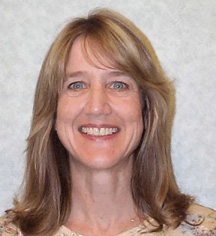 |
Shelley Smith, Ph.D. |
“We are tremendously pleased that we have been awarded this grant,” UNMC Chancellor Harold M. Maurer, M.D. said. “The grant went through an extremely competitive process by the National Institutes of Health and was selected because of its promise to humanity. I could not be more pleased.”
Dr. Smith to lead research center
Through the grant support, UNMC will form a research center to study the relationships between neurosensory conditions and specific genes or gene pathways, including disorders of vision and hearing, as well as touch and balance.
Shelley Smith, Ph.D, director of the UNMC Center for Molecular Genetics, is the principal investigator for the grant and will direct the Nebraska Center for Molecular Biology of Neurosensory Systems.
Four projects, three institutions
Dr. Smith said the COBRE grant for the Nebraska Center for Molecular Biology of Neurosensory Systems will involve four research projects at three different institutions – UNMC, Creighton University and Boys Town National Research Hospital. Three core facilities – all established through the Center for Human Molecular Genetics at UNMC – are part of the COBRE grant, as well, Dr. Smith said.
In one research project, a team of UNMC researchers will study the genes in the auditory system that respond to alcohol exposure in fetal alcohol syndrome. Other studies will involve the effect of growth factors on the development of nerve connections to the skin, genetic factors that protect against viral infections of the nervous system, and the development and maintenance of balance in aging adults.
“Because of the size of this grant, the proposal underwent enormous review,” said Thomas Rosenquist, Ph.D, vice chancellor for research at UNMC. “These (CoBRE) grants are highly competitive because they’re so big and because they’re extraordinarily valuable to the state.”
Testament to the world-class work at UNMC
U.S. Sen. Chuck Hagel said the award reflects the confidence placed in UNMC by the NIH.
“Today’s announcement is testament to the world-class work that is taking place at UNMC,” Hagel said. “Nebraskans and this country greatly benefit from UNMC’s cutting-edge work.”
NIH has recognized UNMC’s work
“U.S. Sen. Ben Nelson said it is no surprise that UNMC is recognized as a preeminent institution by its peers.
“NIH has recognized the cutting-edge work, the superiority of facilities and the leading minds at UNMC by awarding this important biomedical research grant,” Nelson said. “UNMC’s work in this field will bring about advancements in health technology, treatment options and new perspectives in addressing medical challenges.”
Grant offers proof of the state’s medical expertise
Congressman Lee Terry, who represents the Second District, in which UNMC’s main campus resides, said the grant announcement is tremendous news for UNMC and all of Nebraska.
“We can be proud that UNMC has again been recognized for its ground-breaking research, which provides real returns to every resident of our state,” Terry said. “The fact that other local institutions — such as Creighton University and Boys Town National Research Hospital — will take part in the research spurred by this grant is proof of the significant medical expertise in Nebraska.”
Junior scientists take the lead
The four research projects are all led by junior scientists. The intent of the COBRE program is that the junior scientists would use the funding for two to three years, after which they would make a case for independent NIH funding. At that time, additional researchers would use the COBRE funds to begin their own projects. By the end of the five-year COBRE grant, those projects should compete for their own funding, as well.
“We hope to end up with a core of good scientists who can get competitive funding and keep the center going,” Dr. Smith said.
Scientists involved
Initially, the scientists involved in the research projects include Janee van Waes, D.V.M., Ph.D., and Greg Bennett, Ph.D., of UNMC; Laura Hansen, Ph.D., and Kristen Drescher, Ph.D., of Creighton University; and Yunxia Lundberg, Ph.D., of Boys Town National Research Hospital.
Dr. Smith said that mentorship is a strong component of the COBRE grant. Several senior scientists will work closely with the research project scientists. Coordinators at Creighton and Boys Town include Drs. Bernd Fritzsch, Kirk Beisel and Ed Walsh.
“The senior investigators are involved really closely, but it must be the junior investigators’ work,” Dr. Smith said. “It’s not a postdoctoral-type relationship.”
Core facilities
The three core facilities include a microarray facility, which has an ability to analyze the expression of thousands of genes at once; the Mouse Genome Engineering Core Facility, which develops transgenic and knockout mouse lines; and the histology facility, at which the genetic behavior of specific tissues can be studied. Scientists James Eudy, Ph.D., J. Michael Salbaum, Ph.D., and Claudia Kappen, Ph.D., respectively, lead these three facilities. There is also an external advisory board of internationally known experts to provide additional guidance.
Dr. Smith said she’s excited to bring together the research of scientists at the three Omaha institutions who have worked together informally over the years. She said the grant will allow knowledge to be shared throughout the three campuses, as it will provide funds to bring cutting-edge researchers to Omaha for seminars and guest lectures.
Patients will benefit
Ultimately, she said, patients who suffer from the illnesses and diseases being studied will benefit.
“If we can get at the genetic issues, we’ll understand the clinical conditions better and be able to get at them,” Dr. Smith said. “Better clinical treatments will come about because of this work.”